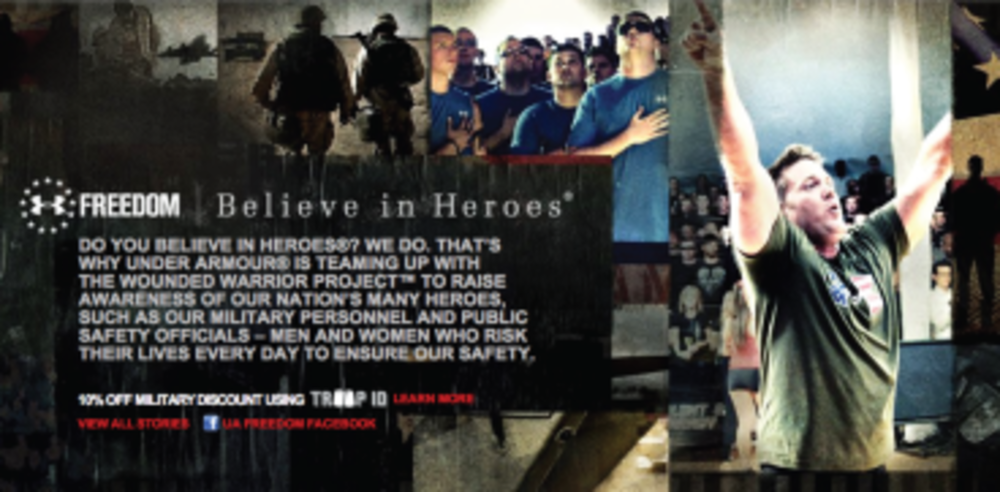With its moisture-wicking performance apparel, Under Armour‘s clothing has long been a hit among military service men and women serving in hot climates like Iraq and Afghanistan. But while Under Armour sells its tactical clothing and gear at military exchanges located on foreign bases, the U.S. retailer also wanted to market its specialty products to military personnel that may not have easy access to an army base or shopping mall.
But that’s not all. With U.S. veterans’ purchasing power reaching $1 trillion annually, and military spouses representing more than 20 million potential customers, Under Armour knew it was time to better target today’s ever-widening military market—and find a way to give back to this loyal consumer group.
So, in 2010 Under Armour launched UA Freedom, an online brand initiative designed to honor and support U.S. military and public safety officials by offering monetary, product, and volunteer support to military troops, police officers, firefighters, and paramedics at home and abroad. As part of the ongoing marketing program, Under Armour teamed up with the Wounded Warrior Project, a nonprofit organization that provides services for injured service members. Between August 2012 and December 2013, Under Armour agreed to donate over $1 million to the Wounded Warrior Project. The UA Freedom site also features inspiring stories of American heroes and wounded warriors.
But when it came time to offer a military discount to service men and women on clothing and gear, Under Armour faced an enormous challenge: how to verify that a consumer is actually eligible for a military discount.
“When you walk into a retail store, you can show your military ID or badge and prove that you’re in the military,” says Bryan Offutt, senior director of outdoor marketing at Under Armour. “However, there’s really not a way to do that online.”
That is, until Under Armour teamed up with ID.me, which offers a verification technology—a secure digital ID card—that allows consumers to prove their identity online. Shoppers need only create an account and attach attributes of their identity, such as military service, to be able to verify to a third party such as Under Armour that they are who they say they are. ID.me relies on authoritative databases to cross-reference information and verify the identity and status of military personnel, first responders, and their family members.
Today, Under Armour offers a 10% online military discount to active duty members, retirees, veterans, military spouses, and military family members, as well as a 10% first responder discount for active police, fire, and EMT customers.
“We wanted to be able to offer a military discount a long time ago and we used to talk about whether we could get our military [customers] to fax in or email us their badge, but that process was just unmanageable,” Offutt recalls. “The ID.me process, though, is just seamless and it’s working great.”
For starters, ID.me has allowed Under Armour to extend its marketing reach by teaming up with organizations such as the United States Automobile Association, Troop ID, and the Wounded Warrior Project to offer online discounts to military personnel. “ID.me has really opened up the doors in terms of reaching out to other organizations that these service members belong to so that we’re able to access a wider audience,” says Offutt.
Another way Under Armour is targeting the military market is by posting news of its discounts and special offers on its Facebook page around Veteran’s Day and other related holidays and events. The retailer also occasionally sends email blasts to registered subscribers with a military background notifying them of special discounts and promotions. As a result, Offutt says, “We’re able to reach family members, caregivers, and veterans—a bigger demographic with military ties.”
These perks could have been offset, however, if Under Armour had opted to manage verification of military personnel in-house. But the high cost of servers, proprietary technology, and the risks associated with storing confidential data convinced the retailer that it was wiser to hand over the reins to ID.me. “That’s one of the biggest reasons we partnered with ID.me— to establish a checkpoint that says, ‘Yes, this individual is eligible for this program.’ while taking us out of the verification process,” Offutt says. “We don’t want to sit here and check every single military ID. ID.me just lets us provide a discount to those service members.”






